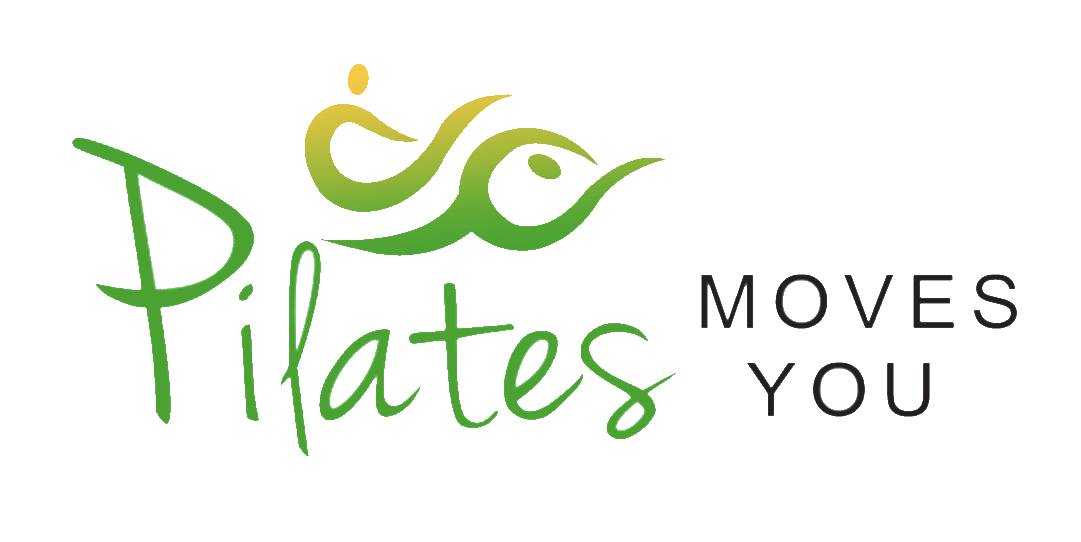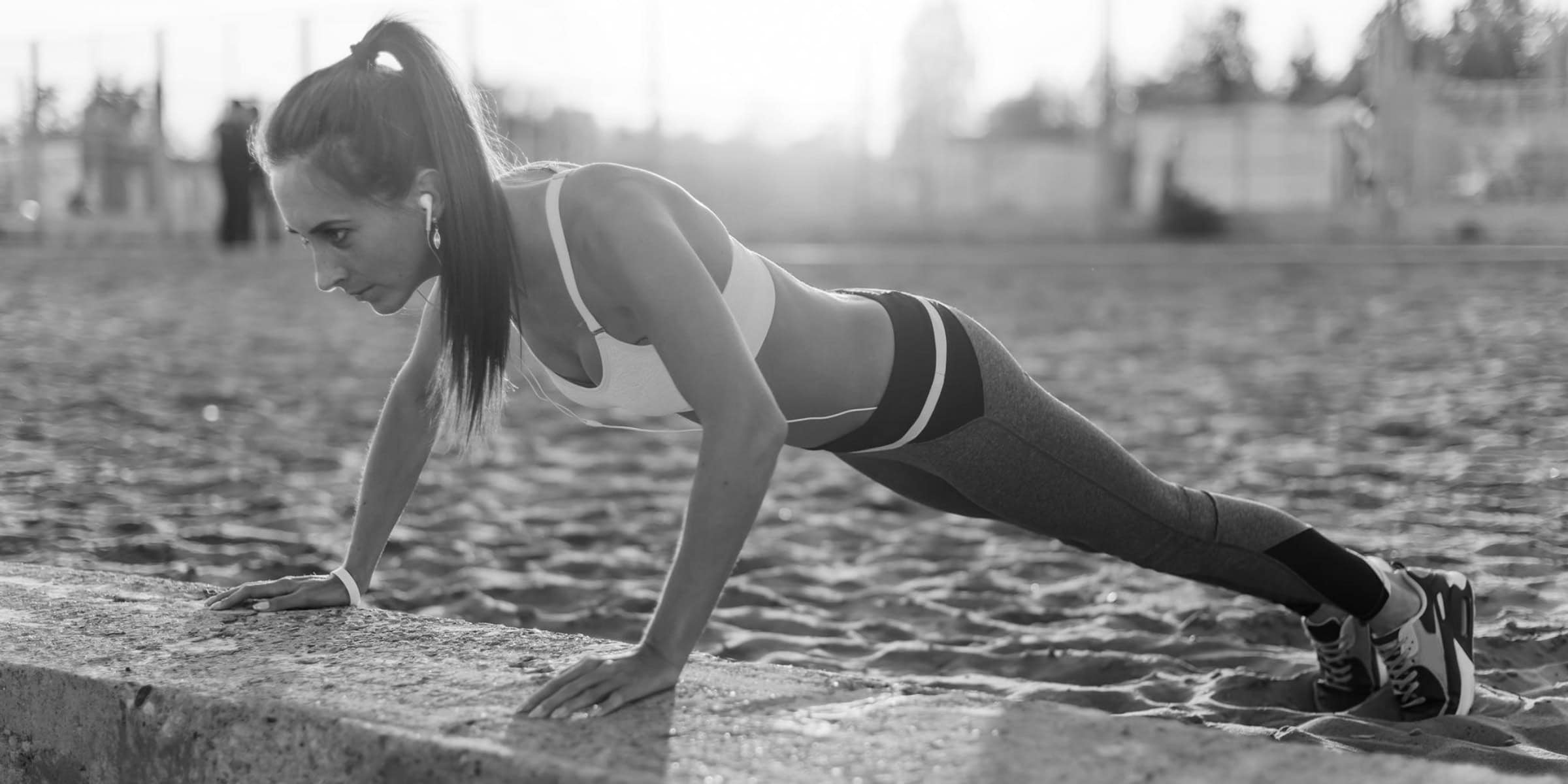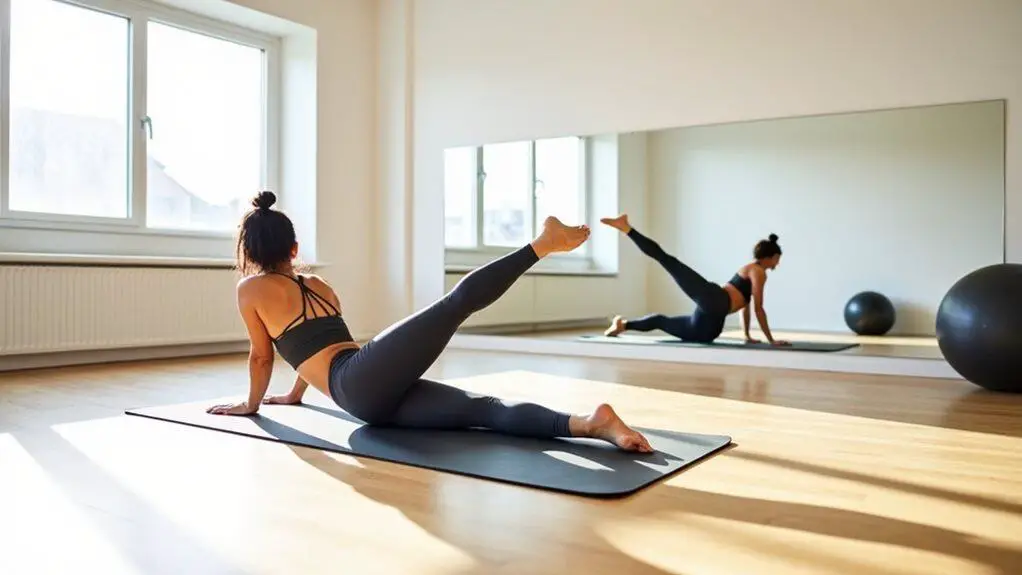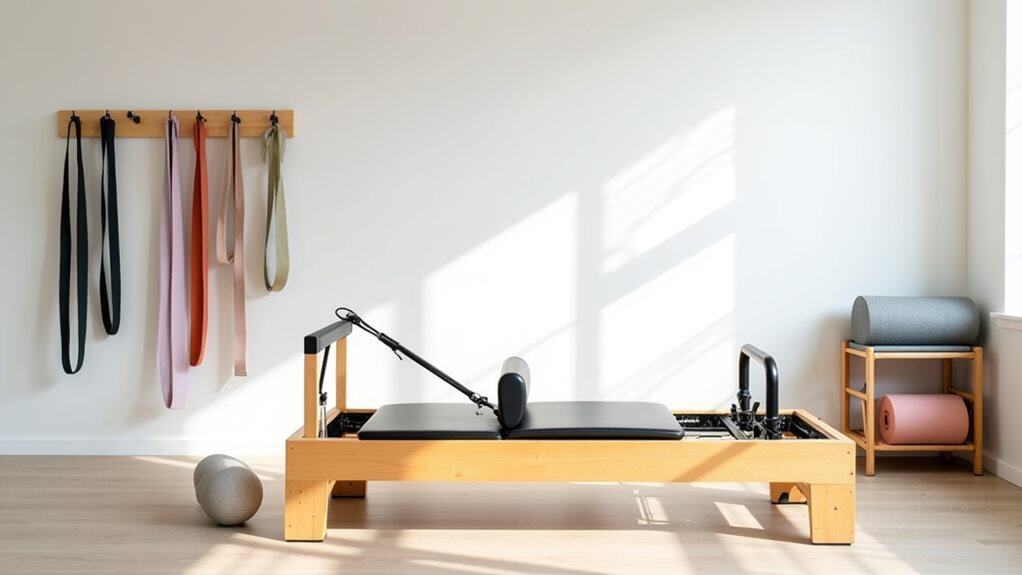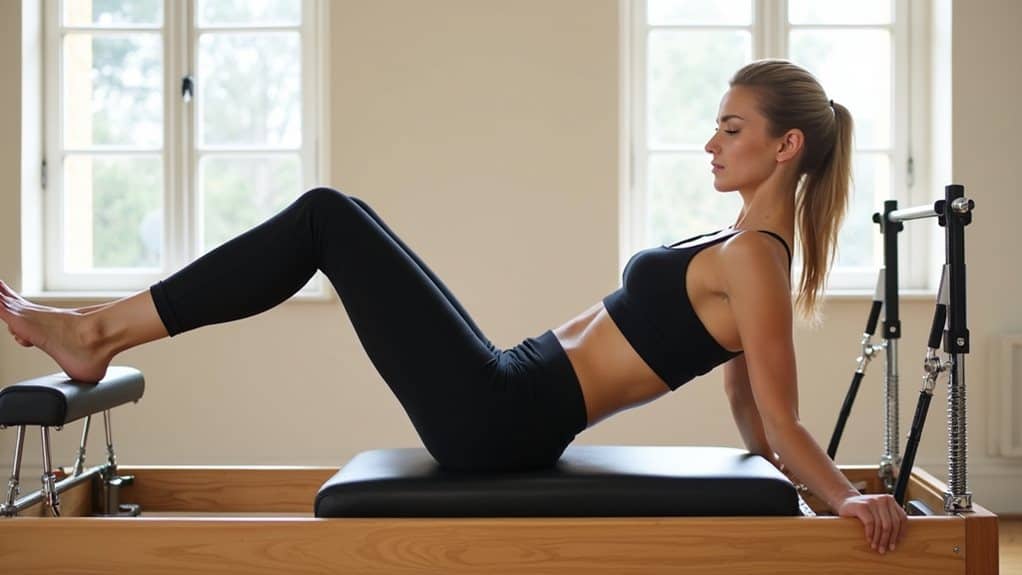Are you tired of feeling weak and sluggish? Do you long for a body that is strong, lean, and full of vitality? Look no further than Pilates training.
Like a gentle breeze that breathes life into a stagnant room, Pilates has the power to transform your body and set you free. With its unique blend of strength, flexibility, and mindfulness, Pilates is the key to unlocking your true potential.
Whether you’re a fitness enthusiast or a beginner seeking a new challenge, Pilates offers a pathway to a stronger, leaner you.
In this article, we will explore the benefits of Pilates training, delve into the principles that make it so effective, and provide you with essential exercises to get you started on your journey.
Get ready to break free from the chains of weakness and step into a world of strength and freedom with Pilates.
Benefits of Pilates Training
You’ll love how Pilates training sculpts your body, giving you a lean and toned physique that’s strong as steel. The benefits of Pilates training are numerous, and it’s no wonder why so many people are turning to this form of exercise to achieve their fitness goals.
One of the key aspects of Pilates is breath control. Throughout the exercises, you’ll learn how to properly breathe, which not only helps to increase your lung capacity but also activates your deep core muscles.
Speaking of core muscles, Pilates is renowned for its ability to strengthen the core. The core is the foundation of your body, and having a strong core not only helps with balance and stability but also improves your overall posture. Pilates exercises target the deep muscles of the abdomen, back, and pelvic floor, working them in a way that traditional exercises often neglect.
In addition to breath control and core strength, Pilates training also improves flexibility and joint mobility. The controlled movements and focus on proper alignment help to lengthen and stretch your muscles, increasing your range of motion and reducing the risk of injury.
So, if you’re looking to get stronger and leaner, Pilates training is the way to go. With its emphasis on breath control and core strength, you’ll not only achieve your fitness goals but also gain a sense of freedom and empowerment in your body.
Understanding the Principles of Pilates
To fully understand the principles of Pilates, it’s important to focus on three key points:
- Breathing and concentration: Proper breathing techniques are essential in Pilates as they help oxygenate the body and promote relaxation. Concentration is crucial for a deeper mind-body connection and ensures each movement is executed with intention and awareness.
- Control and precision in movements: Pilates emphasizes control and precision to ensure movements are carried out accurately and efficiently. This leads to improved strength and flexibility.
- Centering and alignment of the body: Pilates emphasizes centering and alignment to maintain proper posture and balance. This helps to engage the core muscles and support overall body alignment.
Focus on Breathing and Concentration
Immerse yourself in the mindful world of Pilates, where every breath becomes a graceful dance and every thought finds solace in concentration. In Pilates, breathing techniques aren’t just an afterthought, but an integral part of the practice. By focusing on your breath, you can enhance the mind-body connection, allowing for a deeper, more effective workout.
The controlled, rhythmic breathing in Pilates helps to oxygenate your muscles, promoting endurance and strength. As you inhale deeply, envision your breath flowing into the areas of your body that need attention, and as you exhale, imagine releasing tension and stress.
This mindful breathing also calms the mind, allowing you to stay present and fully engaged in each movement. Through the power of mental focus and intentional breathing, Pilates empowers you to find freedom in both your body and mind.
Control and Precision in Movements
Achieving control and precision in your movements is key to unlocking the full potential of your Pilates practice. By focusing on control, you can improve flexibility and increase your body awareness.
Here are five ways to enhance your control and precision during your Pilates training:
- Engage your core: By activating your core muscles, you can stabilize your body and maintain control throughout each movement.
- Concentrate on your breath: Connecting your breath with your movements can help you maintain control and focus.
- Pay attention to alignment: Ensuring proper alignment is crucial for executing movements with precision and preventing injuries.
- Move with intention: Each movement in Pilates should be deliberate and purposeful, allowing you to fully engage the targeted muscles.
- Use props for feedback: Utilizing props like resistance bands or Pilates balls can provide feedback and help you refine your movements.
By incorporating these techniques, you can improve your control and precision, leading to a stronger and leaner body.
Centering and Alignment of the Body
When you center your body and align it properly, you may experience improved stability and increased efficiency in your movements.
Body awareness and postural alignment are key components of Pilates training that can help you achieve these benefits.
By focusing on centering, which involves activating your deep core muscles, you can develop a strong and stable core that supports your movements.
This increased body awareness allows you to better control your body and maintain proper alignment throughout your exercises.
Proper alignment, on the other hand, helps to distribute the workload evenly across your muscles, reducing the risk of injury and maximizing the effectiveness of each movement.
Imagine feeling your body effortlessly flow through each exercise, empowered by a strong and aligned foundation. This is the freedom that Pilates training can offer you.
Essential Pilates Exercises
To effectively strengthen and tone your body, it’s crucial to incorporate essential Pilates exercises into your fitness routine.
Pilates is a form of exercise that focuses on core strengthening and flexibility training, making it an excellent choice for individuals who desire freedom in their movements. By practicing these exercises regularly, you can achieve a stronger and leaner physique.
Here are three essential Pilates exercises that will help you get closer to your fitness goals:
- The Hundred: This exercise targets your core muscles and increases your endurance. By lying on your back, lifting your legs, and pumping your arms, you engage your abdominal muscles and enhance your overall strength.
- The Roll Up: This exercise is fantastic for improving your flexibility and strengthening your core. By lying on your back, reaching forward, and rolling up slowly, you activate your abdominal muscles and stretch your spine, resulting in improved posture and a stronger core.
- The Swan Dive: This exercise focuses on your back muscles and helps you develop a strong and toned upper body. By lying on your stomach, lifting your chest, and reaching your arms forward, you engage your back muscles and improve your overall upper body strength and posture.
Incorporating these essential Pilates exercises into your fitness routine won’t just help you get stronger and leaner but also give you the freedom to move with ease and confidence.
Equipment and Props for Pilates Training
Enhance your Pilates experience and take your workout to the next level with the use of specialized equipment and props. Pilates equipment such as Reformers, Cadillacs, and chairs are designed to provide resistance and support, allowing you to target specific muscles and achieve greater strength and flexibility. These machines use springs, pulleys, and straps to create resistance, challenging your muscles in new and effective ways.
In addition to the equipment, there are various props that can be used to further enhance your Pilates training. Props such as stability balls, resistance bands, and foam rollers can be incorporated into your routine to add variety and intensify your workouts. These props can help improve balance, increase core strength, and provide additional support or resistance as needed.
And if you don’t have these items to hand don’t worry, you can always follow my prop substitution guide and make use of items from around your home.
By incorporating Pilates equipment and props into your workouts, you can expand your exercise repertoire and tailor your training to your specific needs and goals.
Whether you’re looking to build strength, improve flexibility, or rehabilitate from an injury, the use of equipment and props can provide endless possibilities for achieving your desired results. So why limit yourself to just mat exercises when you can explore the vast world of Pilates equipment and props? Step outside your comfort zone and unlock your full potential with these valuable tools.
Designing a Pilates Workout Routine
Revamp your fitness routine with a well-crafted Pilates workout that’ll help you achieve your goals. Creating a personalized Pilates routine is essential to ensure that you’re targeting the areas you want to strengthen and tone.
Here are three tips to help you design a Pilates workout routine that’s tailored to your needs:
- Set specific goals: Determine what you want to achieve through Pilates training. Whether it’s improving your core strength, increasing flexibility, or toning your muscles, setting specific goals will help you stay focused and motivated.
- Mix it up: Incorporate a variety of Pilates exercises into your routine to keep it interesting and challenging. By targeting different muscle groups and using different equipment or props, you can continuously challenge your body and avoid plateaus.
- Maintain consistency: Consistency is key when it comes to Pilates training. Aim to practice Pilates at least two to three times a week to see noticeable results. Schedule your workouts in advance and treat them as non-negotiable appointments with yourself.
By following these tips and creating a well-rounded Pilates routine, you can maintain consistency in your training and achieve the strength and lean physique you desire. Remember, the key is to personalize your routine to fit your goals and make it enjoyable, so you can stick with it in the long run.
Pilates for Rehabilitation and Injury Prevention
Now that you have a solid understanding of how to design a Pilates workout routine, let’s dive into the incredible benefits of Pilates for rehabilitation and injury prevention. Whether you’re recovering from an injury or simply looking to prevent future ones, Pilates offers a wide range of techniques and strategies to support your goals.
Pilates is renowned for its rehabilitation techniques, which focus on restoring strength, flexibility, and balance after an injury. By targeting specific muscle groups and improving joint mobility, Pilates can help you recover faster and more effectively. Additionally, Pilates emphasizes proper alignment and posture, which can alleviate pain caused by poor posture or muscle imbalances.
In terms of injury prevention, Pilates is unparalleled. The practice combines strength training and flexibility exercises, which create a strong and resilient body that is less prone to injuries. Furthermore, Pilates enhances body awareness and mind-body connection, allowing you to identify potential weaknesses or imbalances before they lead to injury.
To give you a visual representation of the rehabilitation and injury prevention techniques offered by Pilates, take a look at the table below:
| Rehabilitation Techniques | Injury Prevention Strategies | Mind-Body Connection |
|---|---|---|
| Targeted muscle activation | Proper body alignment | Improved body awareness |
| Joint mobility exercises | Flexibility training | Mindful movement |
| Balance and stability work | Strength training | Stress reduction |
With Pilates, you can confidently embark on your journey towards a strong, injury-free body.
Finding the Right Pilates Instructor or Studio
Discovering the perfect Pilates instructor or studio can be a game-changer in your journey towards a stronger, injury-free body.
When it comes to finding the right Pilates instructor, it’s important to consider their qualifications and experience. Look for instructors who have completed a comprehensive Pilates training program and have certifications from reputable organizations. This ensures that they have the knowledge and skills to guide you effectively. Additionally, a good instructor should have a deep understanding of anatomy and be able to modify exercises to suit your individual needs.
Choosing the right Pilates studio is equally important. Look for a studio that offers a variety of classes and equipment options. This allows you to progress and challenge yourself as you become stronger. The studio should also have a clean and welcoming environment, with well-maintained equipment.
Take the time to visit different studios and observe a class before making a decision. Pay attention to the instructor’s teaching style and the overall atmosphere of the studio.
Remember, finding the right Pilates instructor or studio is crucial for your success. Don’t be afraid to ask questions and trust your instincts. With the right guidance and support, you can achieve your fitness goals and experience the freedom of a stronger, leaner body.
Tips for Getting the Most Out of Your Pilates Training
To maximize the benefits of your Pilates practice, it’s essential to implement these helpful strategies and techniques. By following these tips, you can ensure that you’re getting the most out of your Pilates training and achieving your goals of improving flexibility and building core strength.
Firstly, focus on proper form and alignment. Pilates is all about precision, so make sure you’re performing each movement with precision and control. This won’t only help you avoid injury but also maximize the effectiveness of each exercise.
Secondly, listen to your body and understand your limits. While it’s important to challenge yourself, it’s equally important to know when to push and when to back off. This will prevent overexertion and promote a safe and sustainable practice.
Additionally, consistency is key. Make Pilates a regular part of your routine to see the best results. Aim for at least two to three sessions per week to maintain progress and continue improving.
Lastly, don’t forget to breathe. Proper breathing techniques are fundamental in Pilates as they help you engage your core and enhance your movements. So, focus on deep, controlled breaths throughout your practice.
By implementing these strategies and techniques, you can make the most out of your Pilates training, improving flexibility, and building core strength. Remember, Pilates is about freedom in movement, so embrace the process and enjoy the journey towards a stronger and leaner you.
Incorporating Pilates into Your Overall Fitness Routine
To get the most out of your overall fitness routine, it’s important to incorporate Pilates into your workouts. Combining Pilates with cardiovascular exercises, such as running or cycling, can help improve your endurance and increase calorie burn.
Cross-training with other forms of exercise, such as weightlifting or yoga, can also help you build strength and flexibility. By creating a well-rounded fitness program that includes Pilates, you can achieve a balanced and effective workout routine.
Combining Pilates with Cardiovascular Exercises
Boost your fitness and burn more calories by incorporating cardio exercises into your Pilates routine. By combining Pilates with cardiovascular exercises, you can maximize the benefits of both workouts. Here are three ways to incorporate cardio into your Pilates routine:
- Start with a five-minute warm-up of jumping jacks, jogging in place, or skipping rope. This’ll get your heart rate up and prepare your body for the Pilates exercises.
- During your Pilates routine, incorporate high-intensity interval training (HIIT) exercises like mountain climbers, burpees, or squat jumps. These exercises’ll increase your heart rate and provide cardiovascular benefits.
- Finish your Pilates session with a 10-minute cardio workout like running, cycling, or jumping rope. This’ll further boost your endurance and help you burn more calories.
By combining Pilates with cardiovascular exercises, you can achieve a strong and lean body while enjoying the freedom of a varied fitness routine.
Cross-Training with Other Forms of Exercise
Mixing up your fitness routine with different types of exercises can help you achieve a well-rounded and enjoyable workout experience. Cross-training with other forms of exercise not only provides variety, but it also offers numerous benefits for your cardiovascular health and helps prevent injuries.
By incorporating activities like swimming, cycling, or running into your workout regimen, you can improve your endurance, increase your heart rate, and strengthen your cardiovascular system. These exercises work different muscle groups and challenge your body in new ways, preventing plateaus and keeping your workouts exciting.
Additionally, cross-training helps prevent overuse injuries by reducing the repetitive strain on specific muscles and joints. By diversifying your workouts and incorporating other forms of exercise, you can maximize the cardiovascular benefits and decrease the risk of injury, ultimately leading to a stronger and leaner physique.
Creating a Well-Rounded Fitness Program
Diversify your fitness program by incorporating a variety of exercises that target different muscle groups, just like a well-balanced meal that includes a mix of protein, carbohydrates, and vegetables to nourish your body in different ways. This will help you create a well-rounded fitness program that not only improves your overall strength but also enhances your functional abilities. By incorporating functional training exercises, you can improve your body’s ability to perform everyday tasks more efficiently and reduce the risk of injury. Strength training exercises, on the other hand, will help you build lean muscle mass and increase your overall strength. To give you an idea of how to create a well-rounded fitness program, here’s a table that outlines different types of exercises and the muscle groups they target:
| Exercise Type | Muscle Groups Targeted |
|---|---|
| Strength Training | Legs, arms, core |
| Cardiovascular | Heart, lungs |
| Flexibility | Muscles, joints |
| Functional Training | Full body |
By incorporating a mix of these exercise types into your fitness program, you can create a balanced routine that targets different aspects of your fitness goals. Remember, the key to a successful fitness program is variety and consistency. So, keep challenging yourself and enjoy the freedom of a well-rounded fitness journey.
Conclusion
Congratulations on completing the article! You’ve learned about the numerous benefits of Pilates training, from building strength and lean muscle to improving flexibility and posture.
By understanding the principles of Pilates and incorporating essential exercises into your routine, you can achieve a stronger and healthier body.
Whether you choose to practice at home or join a studio, finding the right instructor is crucial for proper guidance. Remember to listen to your body and make Pilates a part of your overall fitness routine for maximum results.
So, grab your mat and get ready for a transformative journey towards a stronger, leaner you. Start your Pilates journey today!
